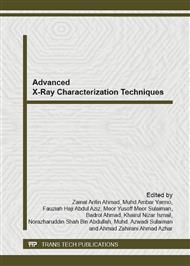p.458
p.464
p.469
p.474
p.480
p.486
p.491
p.496
p.502
Quantitative Energy Dispersive X-Ray Flourescence Analysis of Low Alloy Steel by Regression and Modified Fundamental Parameter Techniques
Abstract:
EDXRF analysis provides several important advantages such as simultaneous determination of the elements present, analyses of wide concentration ranges, and fast analysis with no sample preparation. The paper relates a comparative quantitative analysis using regression and modified Fundamental Parameter Technique FPT methods in the determination of minor elements present in low alloy steel. Regression was developed by plotting calibration graphs using low alloy reference standards while the modified FPT method involves incorporation of pure metal spectrum to the existing equation to improve on the accuracy of the analysis. Discrepancy tests carried out for the two methods showed that the error ranges were 0.3-6.5% and 1.2-7.9% for regression and modified FPT analyses, respectively. This makes the FPT method more acceptable for quantitative analysis of elements present in low alloy steel.
Info:
Periodical:
Pages:
480-485
Citation:
Online since:
December 2012
Keywords:
Price:
Сopyright:
© 2013 Trans Tech Publications Ltd. All Rights Reserved
Share:
Citation:


